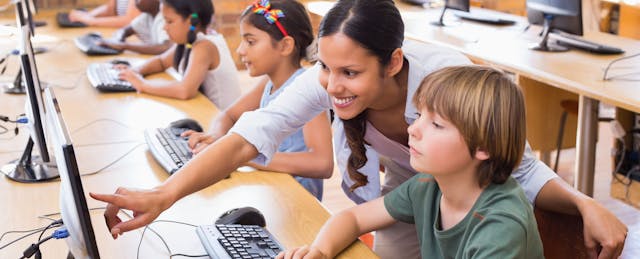In many classrooms, students demonstrate an enviable tech savviness as they easily navigate new applications with grace and little fear. Need your computer hooked up to the projector? There is a good chance at least one student can do it for you. Need help getting the WiFi booster to work properly? Ask a student.
There is no question that today’s schools are filled with digitally savvy children who have grown up with technology and the internet of things. But a discrepancy exists when considering students’ digital fluency compared with their digital literacy, and both sets of skills are required in their future.
Recently, EdSurge podcast host Carl Hooker discussed the importance of advancing digital literacy with field experts Rebecca Young, Natasha Adebiyi and Jon Gregori. The webinar, sponsored by Dell, offers advice and reflection on advancing students’ digital literacy skills.
Defining digital literacy
Digital literacy is the ability to navigate, consume, create and communicate online information appropriately in the digital world. Such skills can include media literacy, visual literacy and technology fluency, depending on the class age and context. Young, a learning specialist and instructional technology coach at Plainfield School District in Illinois, describes digital literacy as “having all the skills that are necessary not only to be safe but productive and successful in the digital world we live in.” She continues by suggesting students need to learn how to read a digital room and engage effectively.
Gregori, an innovative learning specialist at Henrico County Public Schools in Virginia, notes that digital literacy is a “modern life skill” that goes beyond digital competencies to include strength in character and citizenship. More than previous generations, students today must learn to think critically and collaborate responsibly as they consume and produce online media.
School districts recognize the need for teaching digital literacy to prepare students for skills they will need to enter the workforce of the future. Adebiyi, an instructional technology specialist at Dekalb County Schools in Georgia, implores schools to “think about the future. There are careers out there not even created yet that we need to prepare students for.” We have to think beyond today and think about our students’ future.
Watch the full “Advancing Digital Literacy for a Digitally Inclusive Future” webinar on-demand now.
Strategies for developing digital literacy in your classroom
While some districts have established an intentional focus on teaching students digital literacy skills starting in primary grades, others are just beginning the curricular journey. Regardless of where your school falls on this progression, the key is to keep pushing for advancement one strategy at a time.
Embed technology tools in daily tasks: Like many other districts across the country, Young describes a “panic pedagogy” forced on her colleagues by the pandemic. Many districts scrambled to integrate technology for teachers and students to experience a new normal of online learning. But Young cautions teachers not to fall back to pre-pandemic habits. Instead, embrace the digital advances pushed by COVID and embed new practices into your day-to-day curriculum.
Start small: Adebiyi’s advice for hesitant teachers is to “plug in one digital resource and start small.” Don’t feel pressured to implement multiple digital tools suddenly and simultaneously. Not only is this difficult for teachers to plan and establish, but students can become overwhelmed with learning a variety of new applications all at once. Young makes it her goal to “organically embed” new technologies, striving for authenticity over bedazzlement.
Collaborate with colleagues: Teachers often worry they don’t have time to add one more thing to their curriculum, but Adebiyi argues that digital literacy already connects many content areas. Teachers find success in her district by using collaborative planning, adding digital components to competencies already in the curriculum and eventually developing an interdisciplinary, authentic experience for students. Gregori agrees that teachers need the time to collaborate and own their digital literacy development, and students need that same space to build confidence in new skills. His district focuses on communication and multimodal literacy, which allows teachers to continue teaching standards of learning but with enhanced digital opportunities.
Plug into resources: The panelists encourage teachers to reach for the digital literacy tools already established and classroom-ready. Here are a few favorites:
- Common Sense media resources
- ISTE standards for students
- Digital Skills for a Global Society: for students, educators and caregivers from Dell and ISTE
- Digital Literacy in the Classroom: self-paced course for educators from Dell and ISTE
- Richard Culatta’s book “Digital for Good: Raising Kids to Thrive in an Online World”
Create opportunities: Leverage digital literacy in the classroom to build impactful learning. Adebiyi recalls when her third grade students first realized the website they were building could influence the world around them. She introduced a problem-centered movement related to hungry families in the community. With a little guidance, her students took ownership of the mission and raised awareness and funds for those in need. Such opportunities create equity for students, says Gregori. Giving students the space and experience to develop their skills opens more doors for their future.
Partner with parents: Schools need to share with the community at large the importance of digital literacy. Young says the best way to do that is to “meet families where they are.” Invite parents to collaborate with faculty on the appropriate use of technology in the classroom and at home. Give parents the tools and skills they need to model digital literacy for their children. And be deliberate about showcasing students’ digital artifacts—a great hook for getting parents in the classroom.
Just get started: No matter where you are in the digital literacy journey, Adebiyi suggests the key is to focus on digital citizenship early. Elementary students need to learn how to engage with the digital world. As Young notes, students need to learn about their digital footprint before they create one. If they don’t learn in the classroom, they will try to figure it out on their own.
Sponsor’s note: We brought together educators to discuss digital literacy, but that was before we started to see Generative AI like ChatGPT show up in schools across the country. Obviously, this will have huge implications for any discussion about digital literacy in the future, and we plan on making sure we broaden the scope of this conversation.



